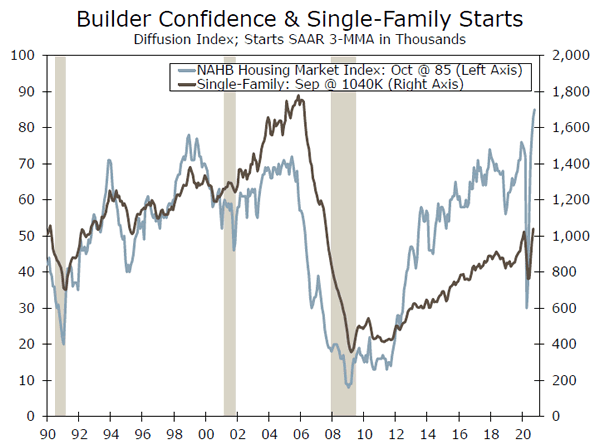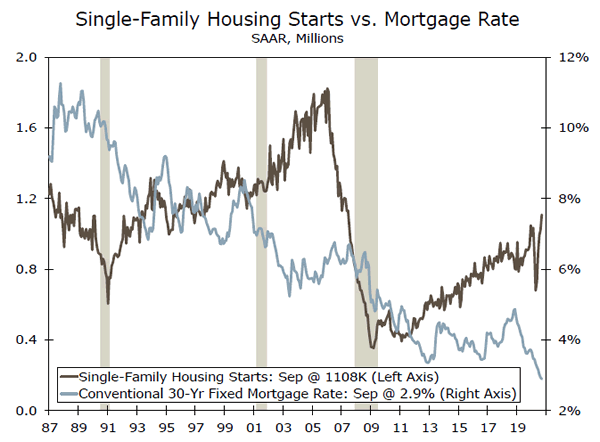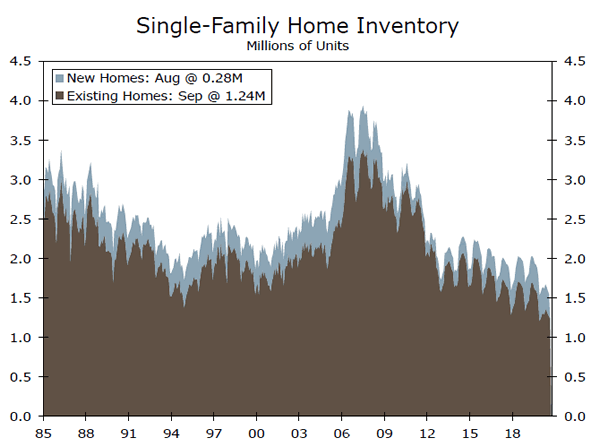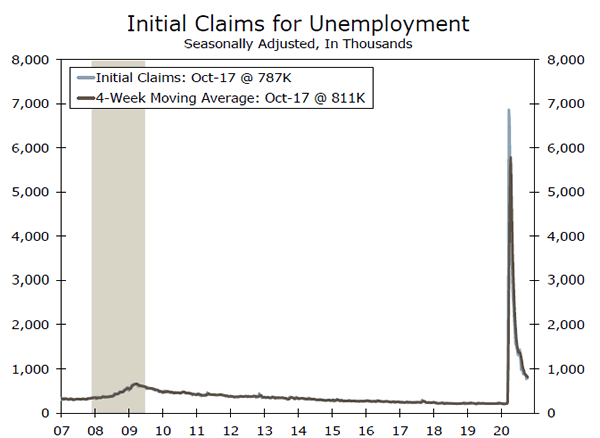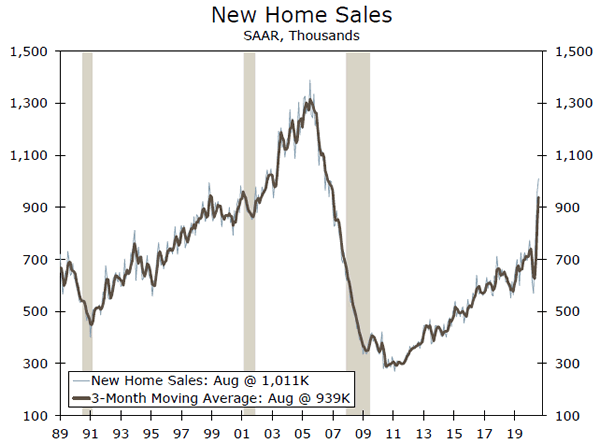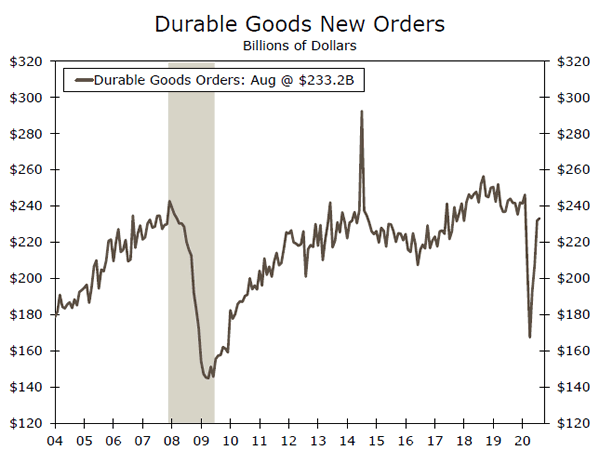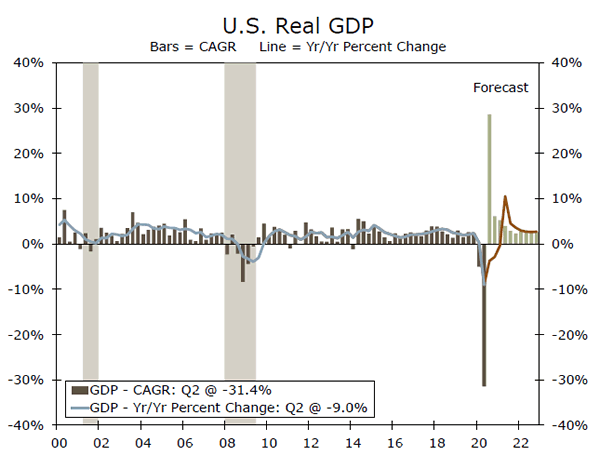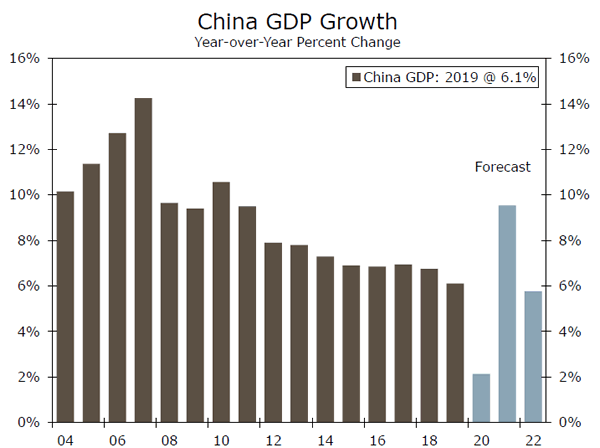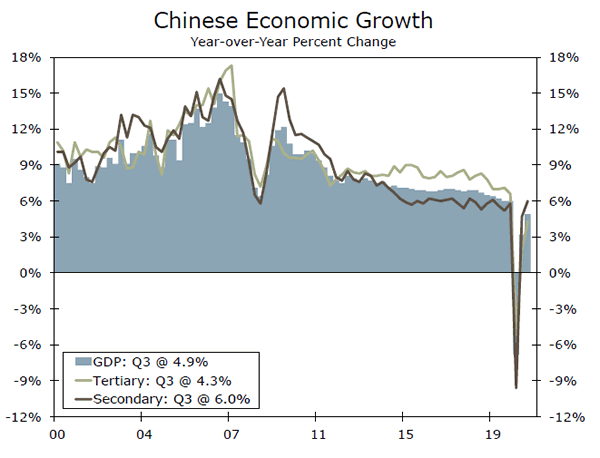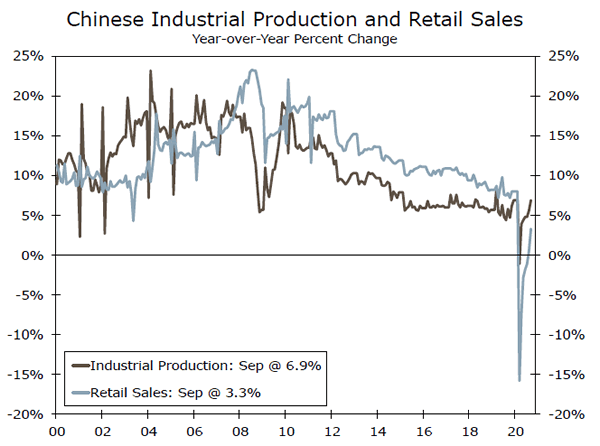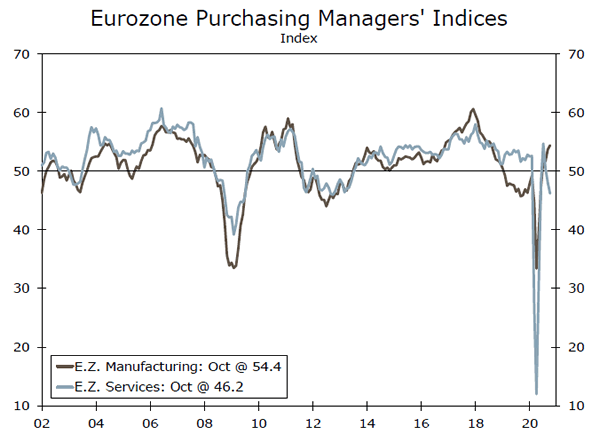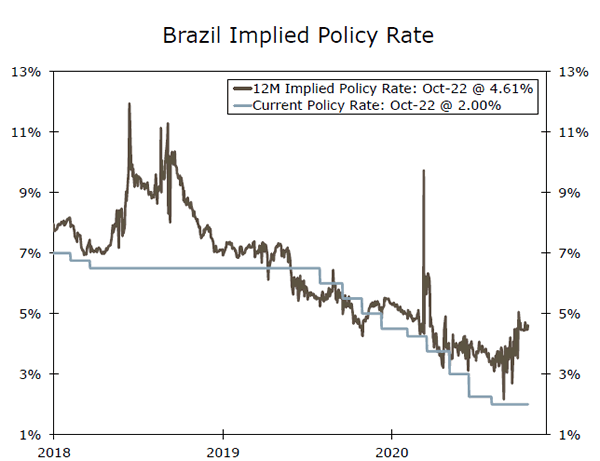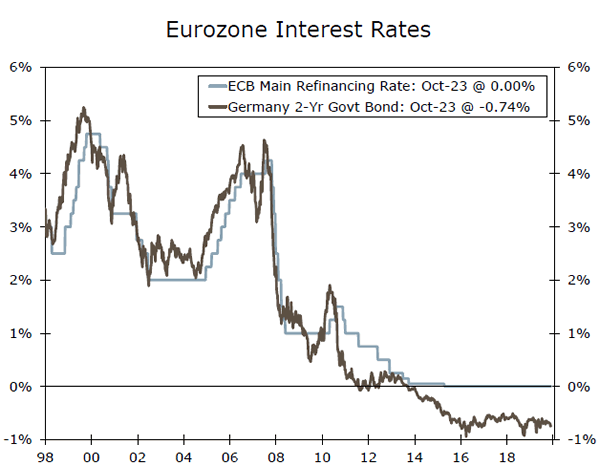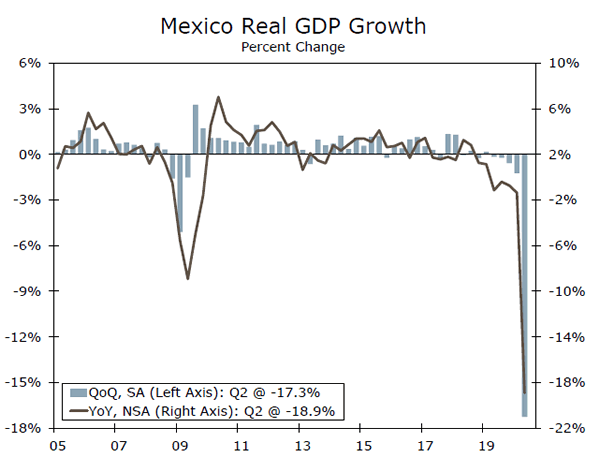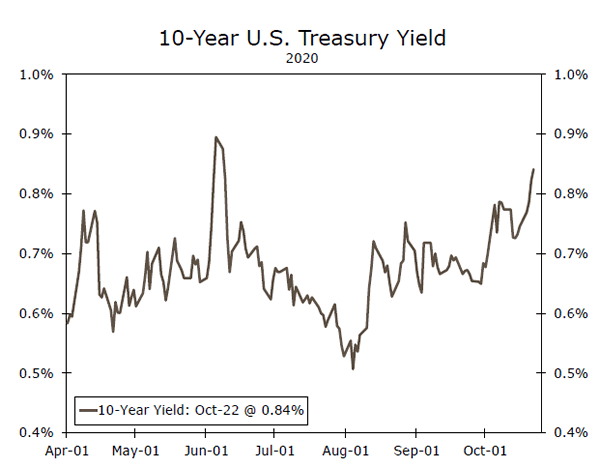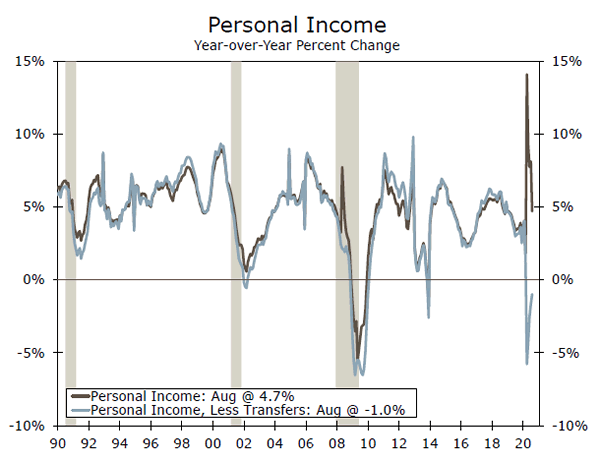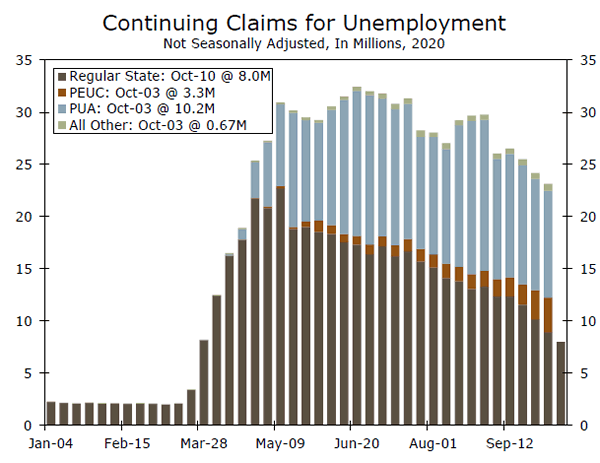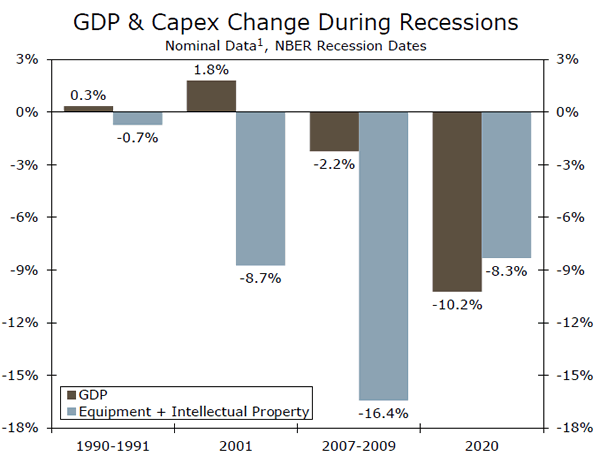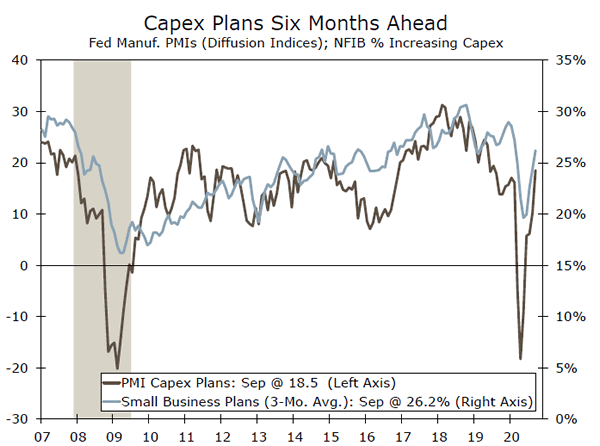U.S. Review
All Things Housing Appear to Be On a Roll
- A recent strong report from the National Association of Homebuilders set the tone for another round of strong housing data. The NAHB index rose two points to a record high 85.
- A drop in new apartment construction led to a below consensus housing starts report but single-family starts rose solidly.
- Existing home sales easily topped expectations, with sales jumping 9.4% to a 6.54-million unit pace.
- Weekly first-time unemployment claims declined more than expected and continuing claims fell by more than one million.
The Recovery Will Likely Prove Resilient
The only economic story that comes close to rivaling the attention of the extraordinary rebound in the housing sector continues to be the inability of the House and Senate to agree on another stimulus bill. While the implications of not passing additional stimulus are often bandied about, they are far from certain. The recovery appears to have strong underlying momentum and will likely continue, with or without additional stimulus. The prospects for the economy would certainly be better with another round of stimulus, however, more stimulus would provide additional downside protection from another pullback in economic engagement if COVID cases surge again, as they are in Europe.
The resurgence in European COVID cases is clearly a cause for concern. At the onset of the virus, Europe led the United States by about two weeks. Several countries, including France, Spain, Italy, Germany, Belgium and the Netherlands have seen the number of new cases shoot well past the spring’s highs. Case counts in France, a country with around one-fifth of the U.S. population, are particularly jarring with more than 40,000 new infections reported yesterday. Adjusted for population, recent new caseloads in Europe would be the equivalent of more than 200,000 new cases per day in the United States.
While a resurgence in COVID cases would likely trigger a pullback in consumer engagement, most of that would probably be at restaurants, stores and entertainment venues. Such an event would slow the recovery but likely not reverse it. The recovery has strong underlying momentum, most evident in the housing sector. The Wells Fargo/NAHB Housing Market Index increased two points to a record 85 in October. The present sales index rose two points to 90 and future sales rose three points to 88. The bulk of the increase occurred in the West and the Northeast.
The strength in the NAHB suggests single-family construction should remain strong in October, when building activity normally slows. The unprecedented lack of homes available for sale, along with strong demand from first-time buyers and trade-up buyers, provides a powerful incentive for builders to push a little harder in what is typically a slower part of the year for home buying.
Home buying certainly looks like it will hold up well this fall. Home sales typically fall off once children return to school, the weather turns cooler, football season heats up and workers focus on finishing up projects before the approach of the holiday season. This year is anything but normal. With children and young adults learning at home along with the parents working remotely, the search for more functional living space will likely keep home sales and new construction at a strong pace well into the fall.
Weekly first-time claims for unemployment insurance continue to recede from their all-time highs, reflecting the gradual reopening of businesses in large states, such as California and New York, which have been slower to reopen their economies. The pace of improvement in jobless claims has moderated, however, as a large share of industries that can more easily implement social distancing have already recovered and the high-contact parts of the economy are still operating under highly restrictive capacity limits.
U.S. Outlook
New Home Sales • Monday
Sales of new homes rose 4.8% to a 1.011-million unit pace during August. This robust upturn was the strongest pace of sales since September 2006. Sales were especially strong in the South, which registered the fastest pace of sales (636,000) since 2005. The region’s outperformance is likely owed to the on-going shift away from higher-cost areas in the West and Northeast.
Despite record-low mortgage rates, it will likely be difficult to sustain such a rapid pace of sales. Employment growth appears to be moderating, which may soon begin to cut into demand for housing. Inventories also remain low, suggesting builders are selling homes faster than they can build them. Lumber prices have begun to ease recently but remain very high, which may delay new construction. Overall, we expect new homes sales to remain strong, but some moderation in growth is likely in the months ahead.
Previous: 4.8% Wells Fargo: 1.1% Consensus: 1.4%
Durable Goods Orders • Tuesday
Durable goods orders increased just 0.5% during August, a sharp slowdown compared to the sizable 11.7% gain in July. The downshift for the month was partially owed to a 4.0% drop in motor vehicle orders, as pent-up demand for autos from the lockdown period looks to be showing signs of exhaustion. Core orders, or nondefense capital goods orders excluding aircraft, held up much better and rose 1.8%. The better-than-expected outcome in core orders in August suggests that the recovery in capex is not coming to a grinding halt.
Considering the recent strength, however, some softening in growth in coming in months is likely. Still, nondefense capex shipments rose 3.3% during the month and are up 33% on an annualized basis over the past two months. Overall, the relative strength in shipments signals equipment spending will be a key contributor to the expected bounce-back in GDP in the third quarter.
Previous: 0.5% Wells Fargo: -0.2% Consensus: 0.6%
GDP • Thursday
Real GDP fell by a nearly unprecedented 31.4% annualized rate during Q2. The plummet in economic activity occurred as stay-athome orders were issued and many businesses were closed in order to suppress the spread of COVID. Despite regional outbreaks continuing throughout the summer and fall, much of the country has reopened and economic conditions have largely improved.
We estimate that real GDP expanded at a 28.6% annualized rate in Q3. Stimulus checks and expanded unemployment benefits have significantly boosted household incomes, which likely fueled a rapid recovery in consumer durable goods spending. Low mortgage rates and a need for more livable space has likewise generated a swift bounce-back in home sales and residential construction. Business investment has also likely turned up, although nonresidential construction is still weak alongside rising vacancy rates and depressed drilling activity in the oil and gas sector.
Previous: -31.4% Wells Fargo: 28.6% Consensus: 32.0%
Global Review
China Leading the Global Economic Recovery
- Q3 GDP data revealed China is still leading the global economic recovery from the COVID induced downturn. In addition, leading indicators of activity beat expectations in September, giving us slightly more optimism around the health of China’s economy heading into the end of the year.
- As Eurozone countries grapple with a second wave of COVID cases and new localized lockdown protocol, activity and sentiment data could start to deteriorate. In that context, the services PMI declined more than expected in October; however, the manufacturing PMI beat expectations and surprised to the upside.
China Recovery Rolling Right Along
Earlier this week, Chinese Q3 GDP data were released, revealing that China is still leading the global economic recovery from the effects of COVID. Q3 GDP data revealed the economic rebound is still gathering momentum and remains uninterrupted in China. On a year-over-year basis, China’s economy expanded 4.9% in Q3, slightly lower than consensus forecasts as well as our estimates; however, still greater than the 3.2% year-over-year expansion in Q2. The tertiary sector (i.e.: wholesale and retail trade, financial sector, real estate) grew 4.3%, while the secondary sector (i.e.: manufacturing, construction) expanded 6%. As China’s economy continues to demonstrate resilience and outperform expectations, we have consistently revised our 2020 GDP forecast higher. The combination of a quicker-than-expected virus containment, a swift re-opening of the economy, combined with forceful monetary and fiscal stimulus, have led us to revise our GDP forecasts higher over the past five months. As of our latest (mid-October) forecast, we estimate the Chinese economy will expand 2.4% this year. Assuming our forecast is accurate, China will be the only major economy in the world to register positive growth in 2020.
Despite multiple upward revisions, we believe risks around our GDP forecast are still tilted to the upside. Alongside Q3 GDP, indicators of monthly economic activity were also released, which gives us additional optimism around the health of the Chinese economy. September industrial production beat expectations and rose 6.9% year-over-year, while retail sales also came in above consensus forecasts in September, rising 3.3% year-over-year. Higher-than-expected industrial production could mean supply chain disruptions experienced earlier in the year are beginning to ease, while firmer retail sales could be a signal consumer spending is starting to pick-up despite unemployment rates still higher than pre-pandemic levels. In response to Q3 GDP and better-thanexpected industrial production and retail sales, China’s local financial markets responded positively. The Shanghai composite equity index rose in the immediate aftermath of the data releases, while the renminbi strengthened to its strongest point year-todate. Going forward, should economic indicators continue to outperform, we could make additional upward revisions to our GDP forecast for the Chinese economy.
Mixed Signals Out of the Eurozone
The past few weeks have been difficult for the Eurozone. Confirmed COVID cases across the region have jumped significantly, with France, Spain and Italy imposing new lockdown protocol in highly infected areas. These new restrictions raise downside risks to the Eurozone’s economic recovery and could weigh on activity and sentiment data as we head into the end of the year. This week we received manufacturing and services PMI data, key data points when gauging the strength and recovery of the Eurozone economy. Results were mixed, as the services PMI fell more than expected in October to 46.2 from 48.0. However, the manufacturing PMI rose to 54.4, which is particularly impressive as consensus forecasts called for a modest decline. While the manufacturing PMI held up nicely in October, the spread of the virus across major European countries is likely to weigh on sentiment going forward. Should the virus continue to spread and new restrictions be put in place, activity and sentiment data could deteriorate to the point where we would revise our GDP forecast.
Global Outlook
Brazilian Central Bank • Wednesday
The Brazilian Central Bank (BCB) eased monetary policy aggressively this year as the economy has been ravaged by the COVID crisis. However, the economy has demonstrated signs of improvement over the last few months as the combination of lower interest rates and direct cash payments has stimulated economic activity across the country. In addition, inflation has started moving higher, which likely gives the BCB more justification to keep its Selic rate on hold for now. In that context, it is very likely the easing cycle in Brazil is over and the BCB will keep rates steady next week. Going forward, the outlook for monetary policy is a bit more uncertain. Markets, are currently pricing in more than 50 bps of hikes over the three months. In our view, despite evidence of improvement, we think it will take longer for the Brazilian economy to fully recover from the effects of COVID and the BCB will keep rates at current levels until the middle of next year.
Previous: 2.00% Wells Fargo: 2.00% Consensus: 2.00%
European Central Bank • Thursday
The ECB will meet next Thursday to assess monetary policy, and while we do not expect any changes, we acknowledge that risks around more easing are rising. For the past few weeks, confirmed COVID cases have increased significantly, leading to new localized lockdown restrictions. With new lockdown protocol in place across some of the major European countries, the likelihood of renewed pressure on the Eurozone economy is rising. With downside risks to the economy building, we think the ECB will begin to take a more dovish stance on the economy as well as monetary policy. While we are not explicitly forecasting interest rate cuts or an increase to the ECB’s quantitative easing program at this time, we think if confirmed COVID cases continue to rise and economic data deteriorate ECB policymakers would ultimately pursue easier monetary policy. In our view, an increase to its QE program would be more likely than interest rate cuts as rates are already negative.
Previous: -0.50% Wells Fargo: -0.50% Consensus: -0.50%
Mexico Q3 GDP • Friday
During the COVID crisis, we expect emerging market economies to come under particular pressure. In our view, Mexico’s economy could come under the most stress as the AMLO administration has not pursued fiscal stimulus and Mexico’s large informal economy makes easier monetary policy somewhat ineffective. The Q2 economic contraction was severe as the economy declined a little over 17% quarter-over-quarter; however, over the past few months, there have been indications the Mexican economy is recovering. Confirmed COVID-19 cases have receded, while some activity and sentiment data have improved. As data rebounds, we have revised our 2020 GDP forecast higher; however, Q3 GDP data will be key in determining how sound the recovery is and if the economy has gathered any momentum heading into the end of the year. We still forecast a contraction of 10.6% in Mexico’s economy this year, although a strong Q3 print could result in another upward revision.
Previous: -17.1% (Quarter-over-Quarter)
Point of View
Interest Rate Watch
Will They or Won’t They?
The 10-year Treasury yield has drifted higher over the past few weeks, and recently it has held above 80bps for the first time since June (top chart). One potential driver of this upward move in rates has been the continued negotiations over a large fiscal stimulus deal between the White House and Democratic leaders in Congress.
While we acknowledge that anything can happen in 2020, we remain skeptical a roughly $2T bill will become law before November 3, and our baseline forecast continues to assume no additional fiscal stimulus. Negotiators have tried and failed to reach a compromise for months, and even if Speaker Pelosi and Treasury Secretary Mnuchin reach an agreement, Senate Republicans have repeatedly expressed skepticism about such a large package.
To complicate matters further, even if all of the political hurdles can be cleared, getting a bill signed into law in just 11 days would be a Herculean task. After a hypothetical deal is struck, it would likely take three or four days to get members of the House back to Washington, D.C., and get the bill to the floor for a vote. It would then need to work its way through the Senate, which could need close to a week before a final vote. Thus, while a grand bargain is still possible, the sand in the hourglass is dwindling.
But, whether a deal comes before the election may not be the only factor driving yields higher. The economy has managed to hang in thus far, with personal income still up 4.7% year-over-year in August despite the expiration of the extra $600 per week in unemployment benefits (middle chart). Other federal unemployment support continues to help backstop the economy (bottom chart).
We also believe a Democratic sweep is the scenario in which a significant (>$1.0 trillion) COVID-relief bill would have the highest probability of becoming law. At present, betting markets give Democrats a 55% chance of taking both chambers of Congress and the White House. Thus, even though additional fiscal stimulus may not come before the election, the odds of it coming at some point in the next couple of quarters are on the rise, in our view.
Credit Market Insights
Let’s Try Something New
According to data released last week, more than 1.5 million new business applications were filed in the third quarter, up 77% from Q2 and up 82% from Q3 last year. While some of this jump may reflect a catch-up from those who were hesitant or unable to file applications in the spring, year-to-date weekly applications are running 22% above the same period last year. If that growth rate holds through December, it would easily be the largest annual jump since the data began in Q3-2004, and more than doubling the previous record of around 9% in 2018. Leading the surge in new business applications has been the non-store retail sector, suggesting that many individuals may be turning their hobbies into businesses and selling their homemade goods for extra cash. That said, other sectors have also seen a surge in new business applications. The number of new business applications indicating a first-wages paid date—associated with a high likelihood of transitioning into a business with payroll— have also increased markedly, in-line with the broader trend.
In such a tumultuous year, it may seem odd that so many individuals are choosing to start a company. It appears, however, that the unprecedented churn in the labor market and fiscal stimulus programs, such as the one-time checks to households and increased unemployment benefits, have allowed some to consider new ventures and pushed others to turn their side hobbies into formal businesses.
Topic of the Week
Herd Immunity: Why Capex is Holding Up
Like most areas of the economy, COVID has upended the typical downturn dynamics of capital spending. Despite the historic collapse in GDP over the first half of 2020, capital investment has declined even less than it did during the Great Recession (top chart). The relatively modest pull back in investment is largely tied to the fact that the service sector, which has been disproportionately hit by the need to “social distance,” tends to be less capital intensive. For example, despite COVID being especially severe on the hospitality and entertainment industries, together these accounted for less than 3% of equipment and intellectual property investment in 2019. In addition, the scramble for companies to facilitate working from home or to reinvent themselves during the pandemic has resulted in a shift in investment needs. A pick-up in some equipment categories like computers and informationrelated products has also thus cushioned the blow to investment from the virus. But, could more typical recessionary dynamics begin to take hold now that businesses made initial outlays to operate during the pandemic?
While the pandemic has pulled forward demand for some equipment, we believe any payback for recent areas of strength should be short-lived, and will not be enough to throw the capital spending recovery into reverse. Further, the fundamental drivers of investment remain supportive of growth. Investment plans are on the upswing (bottom chart) and there may still be some pent-up demand for capital spending because equipment spending peaked a full-year before the pandemic. Meanwhile, credit is inexpensive and generally continues to flow to businesses. In addition, a turnaround in profits gives some scope for internal financing of investment to improve. However, as the virus lingers, overall demand looks set to remain weak, which will limit the drive for companies to invest in the near term. While the pandemic could ultimately be the “pause that refreshes” capital spending, we expect investment will not pick up in a meaningful way until the second half of 2021.




